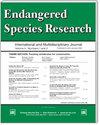Haematologic and plasma biochemical reference intervals for flatback turtles Natator depressus
IF 2.9
2区 环境科学与生态学
Q2 BIODIVERSITY CONSERVATION
引用次数: 0
Abstract
ABSTRACT: Blood reference intervals (RIs) provide an indication of systemic health and are central to any baseline health survey. RIs are available for all sea turtle species, except for the flatback turtle Natator depressus. We developed the first nesting and foraging flatback turtle RIs from a healthy reference population of 211 individuals. We found flatback turtle RIs were generally similar to other published sea turtle RIs. For flatback turtles, we detected significant differences in blood reference values (RVs) by life stage (nesting vs. foraging), sex, and location, as well as by measurement technique (laboratory vs. field). Clinically significant differences justified the establishment of separate RIs for nesting and foraging flatback turtles and for laboratory and field techniques. Clinical application of these blood RIs for individuals in rehabilitation includes disease diagnosis, health monitoring, and the development of prognostic indicators. As sea turtles are regarded as sentinels of environmental health, flatback turtle baseline health data will also be useful for population health monitoring and as a reference for future studies where changes in RIs may indicate an environment in decline.扁背龟的血液学和血浆生化参考区间 Natator depressus
摘要:血液参考区间(RIs)可显示全身健康状况,是任何基线健康调查的核心。除平背龟(Natator depressus)外,所有海龟物种都有参考区间。我们从一个由 211 只海龟组成的健康参考种群中首次制定了筑巢和觅食的平背龟 RIs。我们发现,平背海龟的 RIs 与其他已公布的海龟 RIs 大致相似。对于平背海龟,我们发现不同生命阶段(筑巢与觅食)、性别、地点以及不同测量技术(实验室与现场)的血液参考值(RVs)存在显著差异。临床上的明显差异证明有理由为筑巢和觅食的扁背龟以及实验室和野外技术分别建立参考值。这些用于康复个体的血液 RIs 的临床应用包括疾病诊断、健康监测和预后指标的开发。由于海龟被视为环境健康的哨兵,扁背海龟的基线健康数据也将有助于种群健康监测,并为未来研究提供参考,因为 RIs 的变化可能表明环境正在衰退。
本文章由计算机程序翻译,如有差异,请以英文原文为准。
求助全文
约1分钟内获得全文
求助全文
来源期刊

Endangered Species Research
BIODIVERSITY CONSERVATION-
CiteScore
5.50
自引率
6.50%
发文量
38
审稿时长
31 weeks
期刊介绍:
ESR is international and interdisciplinary. It covers all endangered forms of life on Earth, the threats faced by species and their habitats and the necessary steps that must be undertaken to ensure their conservation. ESR publishes high quality contributions reporting research on all species (and habitats) of conservation concern, whether they be classified as Near Threatened or Threatened (Endangered or Vulnerable) by the International Union for the Conservation of Nature and Natural Resources (IUCN) or highlighted as part of national or regional conservation strategies. Submissions on all aspects of conservation science are welcome.
 求助内容:
求助内容: 应助结果提醒方式:
应助结果提醒方式:


